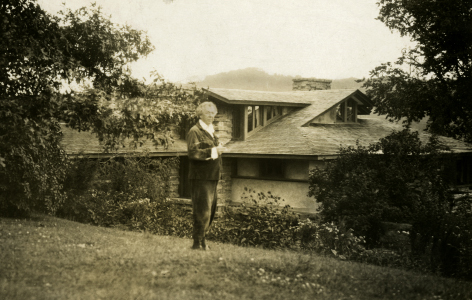Frank Lloyd Wright and Human-centric Architecture
Frank Lloyd Wright was born June 8, 1867 in Richland Center, Wisconsin. His father was a preacher and musician and his mother was a school teacher. Wright’s childhood would be particularly nomadic as his father would take ministry positions from Rhode Island to Iowa, then Massachusetts. They eventually travel back to Wisconsin to settle in Madison in 1878.
In 1885, Wright’s parents would divorce straining an already difficult financial situation. Wright would work for the Dean of Engineering while simultaneously studying engineering at the University of Wisconsin. However, Wright dreamed of being an architect and would leave to move to Chicago in 1887.
In Chicago he would find work doing architectural detailing for J.L. Silsbee. Silsbee, being an excellent drafter, would inspire Wright to achieve a mastery of draughtsmanship. Wright would later work for renowned architectural firm, Adler & Sullivan, where he would work directly under Louis Sullivan, The Father of Skyscrapers, for six years after which he would breach his working contract by accepting private commissions and the two parted ways. However, Sullivan’s adage of “Form Follows Function” would drive Wright’s designs to come.
Wright would design several residences and public buildings that would become the leading models for the “Prairie School” of architecture. Prairie style would run counter to European conventions by having large open planned rooms with minimal walls to emphasize community and connection. The buildings would be made with the naturally available materials of the area which were unpainted and unstained to preserve its natural beauty. Wright wanted harmony between landscape and building. In 1909, Wright would elope from his wife with another lover. He would build his famous home, Taliesin, in Spring Green, Wisconsin. However, a servant of the house would eventually burn the home to the ground and kill his lover among many others. Wright would immediately rebuild Taliesin to “wipe the scar from the hill.”
In 1915, Wright would be commissioned by the Emperor of Japan to build a hotel in Tokyo. Wright claimed the building was earthquake-proof and a year later the claim was tested by the Great Kanto Earthquake in 1923. The Imperial Hotel was one of the only structures to survive.
As a response to the Great Depression in the 1930s, Wright began working on affordable housing which would eventually turn into the “Usonion House.”

Wright, unlike other architects of the time, would pursue architecture for the everyman. He dedicated his work for the betterment of society. Wright believed that architecture was about more than buildings. Architecture is supposed to enrich the lives of those living in the buildings. Wright also believed that structures had to match the environment around them in order to achieve harmony. Truly organic architecture would be designed from the inside out to match its time, place, and inhabitants. As such, he also designed interior elements from lighting to graphics arts. Wright also embraced new technologies and techniques in order to become a pioneer of effects that he could claim as his own. Wright believed architecture, to be “the great mother art, behind which all others are definitely, distinctly and inevitably related.” He was truly inspired by the Japanese idea that everything works in unity to the entirety of civilization art itself. Wright maintained that everyone has the right to live a beautiful life and strove to create affordable housing to achieve this.
Frank Lloyd Wright reminds me of Massimo Vignelli. The constant strive to improve the human condition through design was never something I really thought about until recently.
Sources
- Frank Lloyd Wright; a study in architectural content. by Smith, Norris Kelly
- https://www.architecturaldigest.com/frank-lloyd-wright
- https://www.britannica.com/biography/Frank-Lloyd-Wright
- https://franklloydwright.org/frank-lloyd-wright/
- https://mymodernmet.com/frank-lloyd-wright-architecture/
- https://www.biography.com/artist/frank-lloyd-wright

